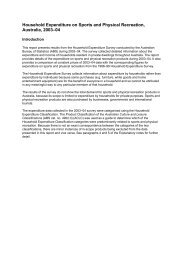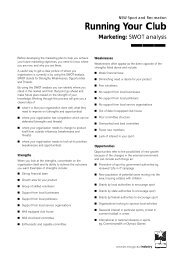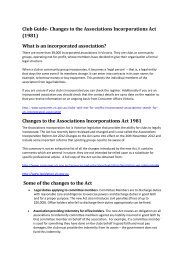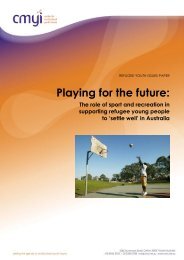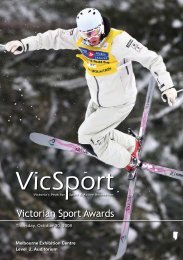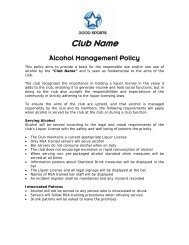School Playing Fields: Planning and Design Guidance - VicSport
School Playing Fields: Planning and Design Guidance - VicSport
School Playing Fields: Planning and Design Guidance - VicSport
Create successful ePaper yourself
Turn your PDF publications into a flip-book with our unique Google optimized e-Paper software.
2: <strong>Design</strong> criteria <strong>and</strong> technical specificationssportscotl<strong>and</strong> has recently completed theNational Audit of Scotl<strong>and</strong>’s Sports Facilitiesaimed at identifying the condition of the nation’sstock of facilities <strong>and</strong> the cost implications ofbringing them up to an acceptable st<strong>and</strong>ard<strong>and</strong> maintaining them thereafter. This studyestablished various grades for the different typesof facilities studied <strong>and</strong> these have been used toset design criteria <strong>and</strong> technical specifications forschool facilities.Synthetic grass pitchesSGPs are those surfaces which provide anartificial alternative to natural grass for the playingof winter sports. They can be particularly usefulin the school context as they are able to copewith much more intensive use, require lessmaintenance <strong>and</strong> are less affected by severeweather conditions than natural grass. They maybe especially useful in situations where there issignificant dem<strong>and</strong> for use of a school’s facilitiesby the community. A synthetic surface is capableof being used constantly throughout the schoolday, after school <strong>and</strong> by the community atevenings <strong>and</strong> weekends, though it should berecognised that high levels of use will increaseroutine, periodic <strong>and</strong> refurbishment maintenancerequirements. Artificial grass cricket wickets arealso effective in a school setting allowing a true<strong>and</strong> safe surface to be easily provided <strong>and</strong>maintained at comparatively little cost.No single carpet type is suitable for all sports<strong>and</strong>, while they are very valuable facilities, overdependence upon SGPs can reduce <strong>and</strong> restrictthe range of sports that can be taught. Forexample, not all surfaces are suitable for rugbyskills practice <strong>and</strong> although some surfaces aresuitable for shinty, the pitch dimensions requiredfor a match are unlikely to be provided by an SGP.Different sports require different playingcharacteristics <strong>and</strong> their respective governingbodies stipulate precise requirements. Choosinga priority sport may mean that certain playingcharacteristics are not ideal for – or evencompatible with – other sports. Governing bodiesof sport identify in their technical specificationsperformance requirements for surfaces in areassuch as ball surface properties (such as roll <strong>and</strong>rebound characteristics) <strong>and</strong> player surfaceproperties (such as traction <strong>and</strong> verticaldeformation).Most existing SGPs are multi-purpose facilitiescatering for as many sports as possible <strong>and</strong> tendto be a compromise between the main sportinguses of football <strong>and</strong> hockey. More recenttechnical developments have tried to createsurfaces which more closely match the playingcharacteristics of natural grass <strong>and</strong> meet theperformance requirements of different sports.Today there are a large number of artificialsurfaces available, most of which look similar butmay be made of different materials, manufacturedby different techniques <strong>and</strong> designed for use indifferent ways. The most basic distinction has untilrecent years been between filled <strong>and</strong> non-filledartificial grass systems.In filled systems, the pile of the artificial grass isfilled to within about 3mm of the fibre tips with afine granular material, such as silica s<strong>and</strong>. Playtakes place on the composite bed of fibre <strong>and</strong>s<strong>and</strong>. S<strong>and</strong> dressed systems are a developmentof the filled system – the carpet pile being denser<strong>and</strong> shorter <strong>and</strong> with a reduced quantity of infill.This produces a slower surface <strong>and</strong> allows theboot or stick to get under the ball.Non-filled surfaces consist of carpet alone <strong>and</strong>play takes place entirely on the fibre. The pile ofthe carpet has to be much denser per unit areato support the player <strong>and</strong> the stresses of play.This type of carpet is used almost entirely forhockey <strong>and</strong> the ball speed is regulated bywatering the surface.Third generation carpets more closely mimicthe playing characteristics of good quality naturalgrass surfaces. The pile length is longer <strong>and</strong>more open <strong>and</strong> can be infilled with either acombination of s<strong>and</strong> <strong>and</strong> rubber granulate orsolely rubber granulate, or have no infill at all.The different types of system <strong>and</strong> their suitability fora range of sports can be characterised as follows:S<strong>and</strong> filled/dressedMulti-purpose facilities able to cater for a varietyof sports including football, hockey, basketball,netball, volleyball <strong>and</strong> even tennis.Water basedHigh specification hockey surface.Third generation (long pile)High specification football surface but also rugbyskills practice.Third generation (short pile)Primarily football but also rugby skills practice,hockey <strong>and</strong> shinty.In most cases, schools with a single SGP willrequire a multi-purpose facility. If a second SGPis provided, a more specialist surface (typicallyfor football) can be specified. In urban areas withmore than one SGP (whether at schools orcommunity playing fields), it may be possible toprovide different surface types at each to bestsuit a range of sports. Ultimately, however, it isfor local education authorities to determine therequirements for each school, taking into accountcurricular requirements, the most popular sportsat the school, local community dem<strong>and</strong> <strong>and</strong> theCouncil’s sports pitches strategy.FencingSGPs must be enclosed for security <strong>and</strong> ballstop purposes. Fencing will also help to keepsurfaces clean by preventing dog fouling <strong>and</strong> theaccumulation of wind blown debris. Many earlySGPs were bounded by light rolled mesh orchain link fences but these have been unable towithst<strong>and</strong> the rigours of use, are subject todeterioration behind goal areas <strong>and</strong> vulnerable tov<strong>and</strong>alism. It is recommended that artificial grasspitches be provided with higher quality fences.<strong>School</strong> <strong>Playing</strong> <strong>Fields</strong> 42<strong>School</strong> <strong>Playing</strong> <strong>Fields</strong> 43



